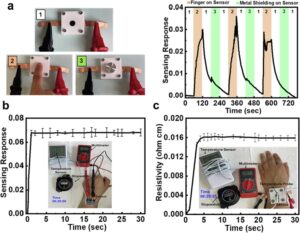Standard clinical care of neonates and the ventilation status of human patients affected with coronavirus disease involves continuous CO2 monitoring. However, existing noninvasive methods are inadequate owing to the rigidity of hard-wired devices, insubstantial gas permeability and high operating temperature. Here, we report a cost-effective transcutaneous CO2 sensing device comprising elastomeric sponges impregnated with oxidized single-walled carbon nanotubes (oxSWCNTs)-based composites. The proposed device features a highly selective CO2 sensing response (detection limit 155 ± 15 ppb), excellent permeability and reliability under a large deformation. A follow-up prospective study not only offers measurement equivalency to existing clinical standards of CO2 monitoring but also provides important additional features. This new modality allowed for skin-to-skin care in neonates and room-temperature CO2 monitoring as compared with clinical standard monitoring system operating at high temperature to substantially enhance the quality for futuristic applications.
Related Publication:
Ahuja, P., Ujjain, S. K., Kukobat, R., Urita, K., Moriguchi, I., Furuse, A., … & Kaneko, K. (2023). Air-permeable redox mediated transcutaneous CO2 sensor. Chemical Engineering Journal, 457, 141260. https://doi.org/10.1016/j.cej.2022.141260
